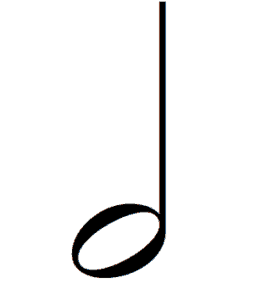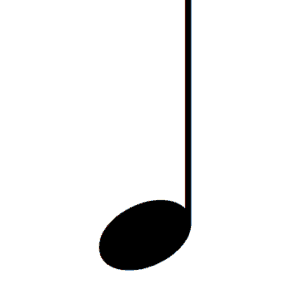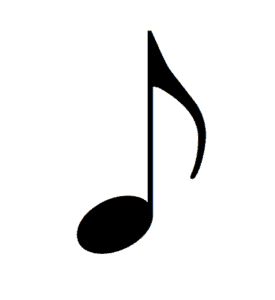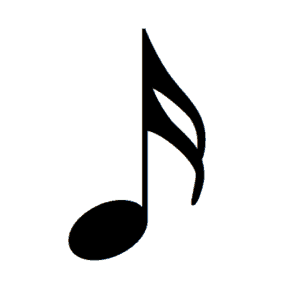Rhythm Notation Introduction
This guide is designed for parents who want to learn the basics of rhythm notation. I try to teach the basics of rhythm (the arrangement of sounds as they move through time¹) to my younger students as early as possible and make it fun by using various games. This guide will help you figure out the basics so you can help your child practice rhythm notation. As this guide makes it as simple as possible to learn Rhythm Notation, I’ve stuck with the familiar American terms vs the slightly more complicated British names.
Rhythm Notation Guide – Terminology
Here are a few terms that I’ll be using throughout this guide that is related to Rhythm:
Beats: In music, we do not use minutes and seconds as a measurement; we use beats and bars. A beat is the main rhythmic unit in music. The beat is held in music by drums or the rhythm section.
Bar: A short section of beats, typically of equal time value, into which a piece of music is divided, shown on a score by vertical lines across the stave.
Rhythm Notation Guide – Note Lengths
Whole Note

First off, We’ve got the most straightforward rhythm notation to remember. The whole note. This denomination lasts for the entire bar, so as we’re in 4/4, we play the note and hold it for four beats as showed below:

Tips & Tricks:
When you’re playing this on guitar, make sure that after the end of the 4th beat the student mutes the strings, so it doesn’t continue to the next bar.
Half Note

As the name suggests, a half note takes up half the bar. Each note is worth two beats as shown here:

Tips & Tricks:
If you enjoy maths, you might notice a start of a pattern; the half note is half the length of a whole note! This knowledge makes the rest of the rhythms more accessible. One of the common mistakes here, especially at first is skipping the second note on the 3rd beat. Remember to play on beats 1 and 3.
Quarter Note

Now if you’ve been listening to the audio examples above you’ve already heard this rhythm, it’s just: 1, 2, 3, 4.

Tips & Tricks:
If you’re struggling with any of the other rhythm lengths, then start with this one. It’s simple: count to 4, and you’ve got 4/4! Another common name for this quarter note rhythm is known as “four-on-the-floor”. It features a lot in my ten songs to help improve rhythm blog post.
Eighth Note

These notes are half the length of quarter notes and the first beamed notes in groups of two or four:

Tips & Tricks
When you count these with your young guitarists, you’ll want to count 1 and 2 and 3 and 4 and. Something that often happens is that students stop counting at 4. It’s important to remember that the bar ends on “and”. As otherwise, it’ll be a quarter note!
As I mentioned before, it’s possible that the notes will be beamed differently depending on the rhythm, and when mixing rhythms (especially in the rhythm game), you’ll often find there will be beams of two. There is no difference in sound; it’s purely to make it easier to read!
Sixteenth Notes

This is when things can get complicated; with sixteenth notes you’re dividing 8th notes by half; So for every quarter note – there are four sixteenth notes!

As you can see written above, you’re looking to say: one e and a two e and a three e and a four e and a.
Tips & Tricks
When you first practice 16th notes, go incredibly slowly. Take your time with this rhythm, and you’ll be fine! Also, remember that this time the bar ends on the “a” rather than 4. This one catches me out on occasions! So remember my advice above….take it slow
Rest Lengths
Now we move onto the rests and their lengths which you’ll be pleased to know they are easier to understand as the terms are interchangeable! Here are all the rests you’ll see in the rhythm around the clock game:
-

<center>Whole Note Rest</center>
-

<center>Half Note Rest </center>
-

<center>Quarter Note Rest </center>
-

<center>Eighth Note Rest</center>
-

<center>Sixteenth Note Rest</center>
Tips & Tricks
These are all self-explanatory except for the Whole and Half note rests, where there is a slightly subtle difference. If you look closely at the Whole Rest is below the second line (known as a staff line) from the top while the half rest is above the third staff line.
Putting it into Practice
I hope that this guide has helped explain the joys and mysteries of rhythm notation! The thing about learning and practicing rhythm is it’s important to keep practicing and working on improving your confidence with rhythm.
[convertkit form=5172446]
Footnotes:
¹ Taken from Rhythm In Music website by Kyle Coughlin.

